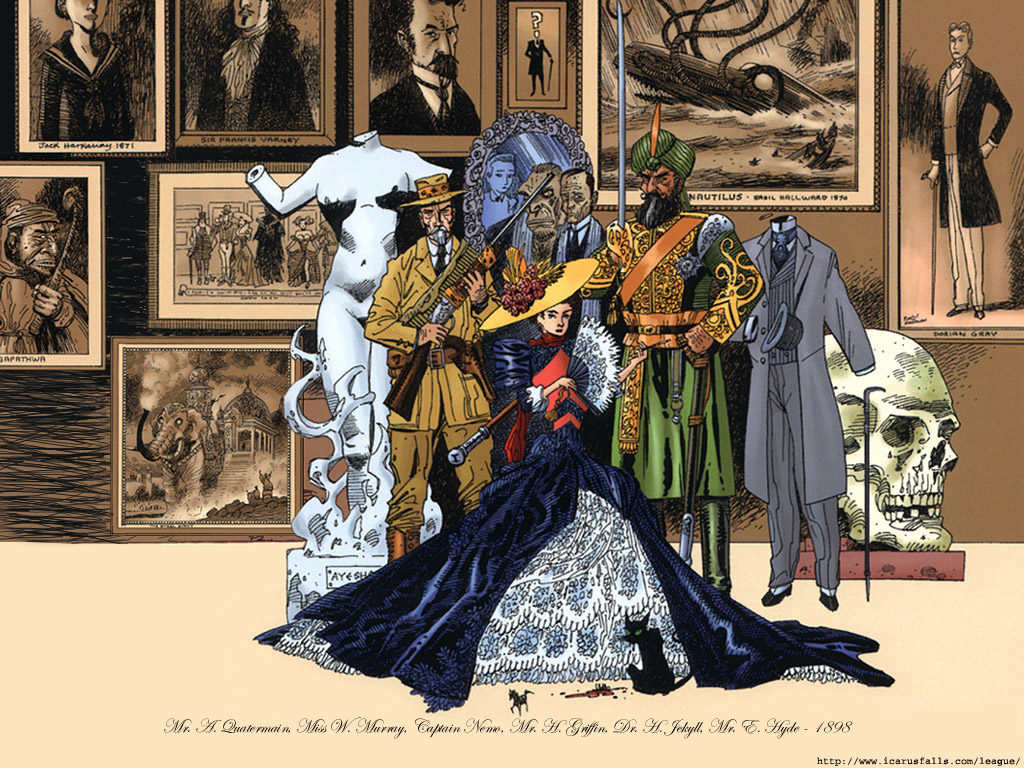Wednesday, August 20

The League of Extraordinary Gentlemen, circa 1898; reprinted with the kindly permission of the Archives Department of the Annexe of the Albion Museum, London
A Caligari Cabinet of Curiosities:
A Journey into the Warped Comic-Book World of The League of Extraordinary Gentlemen
Last week, I spent a very pleasant, albeit unorthodox, evening with my father. We sat in the big dark wood-paneled living room of the white elephant we call our home, and read together the first two sections of the old League of Extraordinary Gentlemen comic book. We like to call the living room the house’s Great Hall, which makes us sound as if we conducted ourselves like Regency gentlemen (not entirely a false impression) but is nonetheless, architecturally speaking, hyperbole.
By now, you’re wondering what the heck is going on here. Why is this young nerdling reading comic books (ahem…graphic novels, whatever) instead of something more edifying? Say Summa or, at the very least, the Manuale Exorcismorum. And why me? Dan’s our X-Men fanatic around here, always mumbling about Dark Phoenixes or something. Of course, the only thing I recall about X-Men was thinking Famke Janssen almost has the same last name as a sixteenth-century Dutch semi-heretic.
You, of course, mustn’t confuse the X-Men with the sedevacantalist graphic novel SSPX-Men (involving Archbishop Lefebre and some radioactive grains of incense…I kid). Nor should you confuse it with the League, though some people are calling it a nineteenth-century incarnation of the theme.
For a brief synopsis, League, authored by Alan Moore, takes well-known characters from nineteenth-century fiction and place them together in a slightly-warped version of the turn of the last century and pits them against vintage villains as Fu Manchu and Moriarty. Mina Murray, the spunky heroine of Dracula, acts as the group’s leader. H. Rider Haggard’s adventurer Alan Quatermain played this role in the film; here the White Hunter shows up, in a flawed, age-worn and perhaps more interesting version of the movie character. I have to admit it was great fun, and almost...almost intellectually stimulating. The movie based on it was a tedious video-gamey shootout, though it had some charmingly hokey moments, lovely period sets and fun steam-powered gadgetry. However, the comic has an interesting edge to it, and it spares us from being subjected to Dorian Grey. Moore has a weird, imaginative genius, and the comic seems like a Jules Verne story illustrated by Edward Gorey to a script by Tim Burton. It may be creepy, but gosh darn, it’s certainly not tedious. Plus, I’d place Mina Murray up there with Irene Adler (i.e. The Woman to fellow Holmesians in the audience) in terms of totally sweet headstrong Victorian Women.
It’s well-drawn, clever even. You’ll find obscure references to Sherlockiana, “steampunk,” Victorian scientific romances and even real literature. It’s the only comic where you’ll find allusions to Trollope, Dracula, and James Bond on the same page. On top of that, the fake Victorian advertisements are twistedly funny, including a paint-by-numbers portrait of Dorian Grey (!!), the “Caligari Self-Assembly Cabinet” and Holmes “Play in a Day Violin Course,” which, if you’re a silent-film buff or a mystery fan are hysterically funny. Be warned, though, fellow Nerds: there’s some unfortunate prurient bits in Chapter Two (so skip over that part, please, trust me here...uck). However, besides the expected murder and mayhem there’s not much else objectionable (compared to, say, Father Ted...I'm kidding, Dan). Plus, the villain’s a Freemason: what’s not to like?
As an artist and a writer the concepts behind comic books have a certain intellectual interest. It potentially is a format that combines the strengths of filmmaking, novel-writing, and serial television in a package which seems in a sense almost like the modern equivalent of a medieval manuscript. Comics remind us Catholics the profound respect the Faith has for the communicative power of images, and their embellishment of and unity with the more “Protestant” written word in expressing the glory of God. It’s no surprise that the first “comic strips” were in illustrations for the Spanish codices containing the Cantigas de Santa Maria, songs in praise of the miracles of the Blessed Virgin. These episodic illuminations showed the healing of lepers, grateful offerings to the shrine of the Virgin, and myriad other wonders. Comics were invented by Catholics!
In the future, I’ll stick to real books, but nonetheless it was a fun divertissement. If you’re the sort of person who reads the footnotes to the Annotated Sherlock Holmes or are curious to see what Captain Nemo does on his day off, you couldn’t find a better way to spend a quiet Victorian evening than with Alan Moore and his wild imagination.
I have to dash. Our heroes are, at present, trying to stop the aerial bombardment of Limehouse by the insidious Dr. Moriarty’s Cavorite-powered superweapon, and time and the Napoleon of Crime wait for no man.












